I look forward to December because it gives all of us a chance to reflect on our achievements over the past year. This year is no different, and I’m extremely proud of the accomplishments of our great team here at Wyoming Game and Fish Department. Wyoming’s people and wildlife faced immense challenges in 2021, and I’m grateful to you and our partners for supporting our work.
Aquatic invasive species continued to be a major concern for Wyoming. For more than 10 years Game and Fish has prioritized keeping AIS out of the state’s lakes and reservoirs. We were challenged when zebra mussels were identified in moss balls, an aquarium plant. It was the first time live mussels were ever found in water in our state. Our agency and the Wyoming Department of Agriculture — alongside many others — mobilized to remove products from shelves and grab the public’s attention to dispose of their moss balls safely. To date we haven’t identified zebra mussels in any natural waters in Wyoming nor municipal systems. Game and Fish formalized 23 rapid response plans to help act quickly if AIS are discovered in any natural waters.
In 2021, the Game and Fish Department Forensics and Fish Health Laboratory received accreditation through the American National Standards Institute’s National Accreditation Board. It’s the top accreditation a lab can acquire, and it makes the Game and Fish facility one of the most trusted wildlife forensic labs in the country. Game and Fish also was able to begin building a new regional office in Cody, after nearly a decade of saving and planning by the Wyoming Game and Fish Commission. That project will be completed in the summer of 2022.
Game and Fish continued work to monitor the spread of wildlife diseases in Wyoming — collecting biological samples to monitor wildlife populations for chronic wasting disease, brucellosis and even rabbit hemorrhagic disease virus 2. In 2021, unfortunately, white-nose syndrome was confirmed for the first time on a bat at Devil’s Tower. Wyoming is the 37th state to confirm the disease, which also has been found in seven Canadian provinces. Wyoming has a white-nose monitoring plan in place, and people can help stop the spread by cleaning their caving gear and clothes thoroughly between excursions.
Involving you in wildlife management decisions remained a top priority. The public collaborative, Elk feedgrounds: A challenge we can take on, asked you what your concerns and thoughts were on Wyoming’s 22 elk feedgrounds. In shared learning sessions Game and Fish listened and answered questions about our operations. Now, those thoughts are fueling in-depth engagement with various stakeholder groups on elk feedgrounds management. Ultimately, the Game and Fish-led process will produce a long-term management plan for elk feedgrounds managed by the department.
Quality and resilient habitat is a cornerstone for healthy wildlife, and Game and Fish embarked the first year of our new Strategic Habitat Plan. The Commission funded $500,000 for fourteen Mule Deer Initiative projects to enhance habitat for mule deer and support the ugulate’s migrations.Through leveraged funds, a total of $3.56 million went on the ground to benefit 2.17 million acres and 35 percent of the state’s mule deer population.
This year marked success for species recovery. We made a strong commitment to wolves and grizzly bears in Wyoming, and the populations are healthy. For the 19th consecutive year, wolf numbers have remained above minimum delisting criteria showing that Wyoming’s wolf management plan works. Similarly, grizzly bear populations have reached population levels and distribution far-beyond recovery. As a result of the hard work of our wildlife managers and the contributions of all of those who work, recreate and live in occupied grizzly bear habitat, we continue to have a healthy recovered population. Wyoming announced it would formally seek state management of grizzly bears again.
While we eased back into a post-pandemic world some things stuck around, namely our expanded use of technology. Most season setting meetings were held online this year, and we shared more information than ever before digitally. Game and Fish also held the 2021 Wyoming Outdoor Expo online. We brought the Wyoming outdoors to over 1 million people online and nearly 3,500 Wyoming school kids.
One substantial technology change this year was the new login portal to buy or apply for Game and Fish licenses, stamps and permits. It became a requirement to have a username or password to use this account. This change was big — but it was needed to offer more services and better protect our customer’s information. You worked with us on this update, and we’re proud to be able to offer more services because of it, like a speedy way to check in at the Springer Special Pheasant Hunt with just a barcode scan.
There are a couple of final achievements that deserve another round of recognition. Casper angler Christopher Bobo broke the 1998 state record for the long-nose sucker. He hauled in the 2 pound, 4.5 ounce hog from the North Platte River. The fish was 18 inches long with a girth of 9.4 inches. Wyoming Wildlife earned multiple local and national awards thanks to the talent and stellar work of our magazine team and all of those who contribute. Last, the Game and Fish Commission commemorated 100 years of work.
This column only represents a sampling of the projects and accomplishments from 2021 that fully embody our mission of Conserving Wildlife — Serving People. On behalf of all at Game and Fish, I thank everyone who contributed to our work this year, and I look forward to 2022.
Reflections on 2021
Sara DiRienzo, public information officer - sara.dirienzo@wyo.gov

